Ferrari
|
1940 - present |
Country: |
 |
|
The Mystique Of The Prancing Horse
We are only too aware that any reference
to the famous marques in this, the
Unique Cars and Parts heritage listing, would be incomplete without mention
of arguably the most famous and desirable exotic ever
built – the Ferrari.
There is an aura that surrounds
the marque, a mystique that exudes from the majestic
'Prancing Horse' whenever you are lucky enough to see
one on the road. No doubt it has been the post war racing
success that has lifted Ferrari to such heady heights,
but our story begins some 20 years earlier when, in
1920, a young 22 year old Enzo Ferrari would join Alfa
Romeo.
Born on February 18, 1898 near Modena in Italy, Enzo
Ferrari became entranced with the idea of car racing
after his father took him to a race meet at age 10 at
a circuit in Bologna. After attending a number of other
races, he decided he wanted to become a racing car driver,
and so he was able to obtain a job working for a small
carmaker involved with converting World War 1 surplus.
His first outing on the race track was at the 1919
Targa
Florio. After landing a job with Alfa Romeo the following
year, he would drive a modified production car in the
1920
Targa Florio - managing to finish second!
The famous 'Prancing Horse' logo would be conceived
in 1923 when Enzo was racing at the Circuit of Sivocci
at Ravenna; now 25, Enzo was approached by Count Enrico
and Countess Paolina Baracca, the parents of the heroic
Italian pilot Francesco Baracca.
The Italian Ace Of Aces
Francesco had been
killed at Mount Montello during the war, but not before
he had gained the reputation as the “Italian Ace
of Aces”. Count Enrico and Countess Paolina gave
Enzo their son's squadron badge, the famous prancing
horse on a yellow shield. Enzo remained connected with
Alfa Romeo for many years; however he built only a few
sports cars bearing his name and his famous prancing
horse badge.
From 1923 he concentrated on organization, rather than
driving, as his abilities as a tactician and manager
were recognized. In 1929, however, he left Alfa Romeo
itself (but remained associated with them) to form his
own racing team, the Scuderia Ferrari, and was entrusted
with the task of running the official Alfa Romeo team
cars.
This arrangement worked well, allowing the parent
factory to concentrate on designing and developing their
next generation of cars. It was at this stage, too,
that the famous 'Prancing Horse' emblem first appeared
on the cars, and it has been used ever since. The Scuderia
Ferrari team would go on to compete in 22 events, scoring
8 victories and several good placings.
All went well for the team until the mid 1930s, when
the German government, determined to win any and all
sporting events, would finance Mercedes-Benz and Auto-Union
to develop
Grand Prix cars; after their arrival the
Alfas could rarely match them again.
Enzo Cuts All Ties With Alfa
In 1940 Enzo Ferrari finally severed all ties with
Alfa Romeo and started a new company, Auto-Avio Costruzioni
Ferrari. During World War II the Ferrari workshop moved
from Modena to Maranello, but this did little to protect
if from allied bombing and the new factory was almost
entirely leveled in 1944. The factory would not be re-built
until 1946, and upon its completion work would begin
on the construction of the first ever Ferrari motorcar,
the 125 Sport – a car that would quickly establish
a grand tradition of winning for Ferrari.
Gioacchino Colombo And The Development Of The V12
Enzo’s first chief engine designer was Gioacchino
Colombo, who produced the classic V12 engine which would
become the mainstay of Ferrari road cars, in so many
different forms, for a great many years to come. The
original V12 engine was a 1500cc single overhead cam
design, and was well suited to the lovely 125 two-seater
as well as Ferrari’s new Formula One race car.
It was at this time that Ferraris management decided
to title their cars in numbers and letters, a 'system'
that quickly became very confusing, and not always logical!
But at least in the early years of development, the
vehicle type number approximated the capacity of ‘one’
engine cylinder in cubic centimeters. A seemingly more
logical system would take over in 1957 when the cars
designation indicated the engine size in litres, and
the number of cylinders - except of course when it inexplicably
didn't! Although Colombo's influence persisted at Ferrari into
the 1960s, he left the company in 1950, and was succeeded
by Aurelio Lampredi. In the meantime the V12 engine
was enlarged to 1955cc and fitted into the Tipo 166.
The Tipo 166 Enters Formula Racing
The Tipo 166 had cycle type wings that, along with the
headlights, could be removed making for an easy conversion
for Formula racing. The Tipo was quick, competitive,
and notched up many racing successes – particularly
in long-distance events requiring reliability and durability
(bet you didn’t expect that of early model Ferraris!). Race driver Biondetti would win the 1948
Mille Miglia,
and to celebrate the success Ferrari would add the letters
“MM” to the cars name. His car had a triple
Weber carburettor setup and was good for 150bhp at 7000rpm,
enhancements that quickly found their way into the production
model Tipo.
The chassis was made from oval-section steel
tubes, and featured double wishbone independent front
suspension, with a transverse spring, while the rigid
rear axle was sprung on half-elliptical leaf springs,
with radius arms for location. The transmission did
not have syncro, but at least the
brakes were hydraulic.
The lovely body for the Tipo 166 was developed by Carrozzeria
Touring, and the car was good for a top speed of 125
mph. A later version of the Tipo, dubbed the “195
Inter” featured an enlarged engine, although this
model was soon succeeded by the 2562cc 170bhp engined
“212 Inter” in 1951. Shorter wheelbase types
became known as the Sport, or Export, models.
The New Lampredi V12
In 1951, however, the first of the really big-engined
Ferraris, the 4101cc “Type 340 America”
went on sale. The America was fitted with a completely
new V12 engine, familiarly known as the Lampredi (as
against the Colombo) type, which was good for 220bhp
at 6000rpm. The car had a top speed of 137mph, and would
soon be offered in further variants such as the “340
Mexico” and “340MM” – all were
raced with great success in the US.
In 1953 and 1954, the factory raced even larger versions
of this car, known as the 375 (4522cc) and later still
they used 4954cc engines. In the last form, the engine
produced a staggering 344bhp at 6500rpm, making the
375 good for a top speed in excess of 160mph, with 0-60
mph acceleration in just under seven seconds.
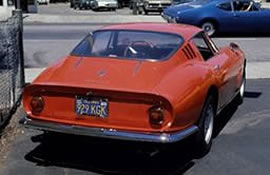
The 275GTV was a new breed of
Ferrari, styled by Pininfarina their sweet V12
engine was good for 280bhp...

A grieving father would ensure
his sons engine, and name, would survive in
the Dino...
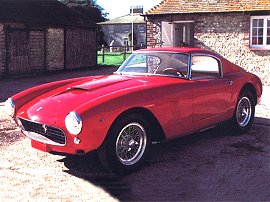
The sleekest and most sophisticated
Ferrari of the 1960's was the beautiful Pininfarina
styled 25OGT Berlinetta Lusso. Although the
mechanical specification was very similar to
that of the SWB Berlinetta, the engine was de-tuned
to a mere 250hp...
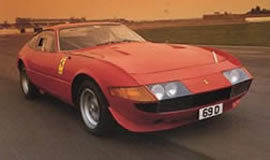
The Daytona is arguably the ultimate
front-engined Ferrari, despite the controversial
wedgey styling...

In mid-1971 Ferrari would make
the Daytona's headlights retractable, well,
sort of...
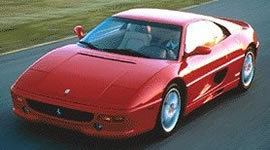
It would take until the F355
for the chassis to improve over the 206GT...

The Maranello captured the classic
style of earlier Ferrari's...
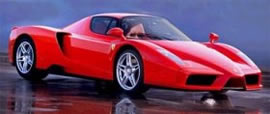
The F60, street-cred wise this
thing is guaranteed to wipe the smile off any
HSV owner... |
The 250 Europa
The first of the famous 250s, the “250 Europa”,
appeared at the Paris Show of 1953, with a 'long' Lampredi
engine, in a 9ft 2in wheelbase (although the Europa
still used the same basic suspension layout of previous
models). The 25OGT Europa would follow in 1954, however
it had a shorter (8ft 6in) wheelbase, and a 3 litre
version of the Colombo V12; in all only around 50 cars
of the two types were produced.
In 1956 Ferrari released the 25OGT Coupe – and
Enzo Ferrari was now keen to ensure the companies viability
by selling more road cars. Styled by ‘Pininfarina’,
approximately 500 of these cars were constructed; the
2953cc V12 engine was much the same as before, but now
developed a healthy 240bhp at 7000rpm using triple Weber
carburettors. Later models would be fitted with Dunlop
disc brakes.
The Classic 250GT Berlinetta
One of the most memorable of the “classic”
Ferraris would follow, the short-wheelbase 25OGT Berlinetta,
which featured Pininfarina style coachwork built for
Ferrari at Scaglietti from 1959 to 1962.
The 250GT Berlinetta
was really a racing sports-car, had a 280bhp V12 engine,
four speed all-synchromesh transmission, disc
brakes all round, but used the same basic chassis and suspension
as other Ferrari road cars. Stirling Moss would have
two successive 250GT Berlinetta victories in Tourist
Trophy races.
Two other 250 theme variations of note were the open
model “Spyder California” (announced in
1958), and the 25OGT 2 + 2 - also known as the GTE.
The latter variant was the first-ever Ferrari to offer
even occasional rear passenger seats.
However, the sleekest
and most sophisticated Ferrari up to that time was the
beautiful Pininfarina styled 25OGT Berlinetta Lusso
- the word Lusso meaning 'Luxury.' Although the mechanical
specification was very similar to that of the SWB Berlinetta,
the engine was de-tuned to a mere 250hp.
During the 1960s, the 'basic' Ferrari power unit grew
to four litres, and then to 4.4 litres, the first of
this new breed being the 330s of 1964. As one might
expect, the engine layout remained as a V12, but was
now good for 300bhp at 6600rpm, though the chassis was
still like that of the 250, with coil spring and wishbone
independent front suspension, and a rigid rear axle
on leaf springs at the rear – of course four wheel
disc
brakes remained.
The original 330GT 2+2, identifiable by its distinctive
four headlamp configuration, was superseded a year later
by the Mk. 2, which reverted to a more traditional two
headlamp configuration. There was also a differently
styled two seater 330GTC from 1965, and a GTS open Spyder
a year later. Although all were styled for Ferrari by
Pininfarina, they were built by Scaglietti.
The Development Of Ferrari Super-Cars
Ferrari were at the same time building, in very limited
numbers, extremely large engined super-cars. The first
was the 4 litre “Tipo 410 Super America”
of 1956, followed by the 3967cc “Tipo 400 Super
America” in 1959. But these paled when Ferrari
raised the curtain on their amazing “Tipo 500
Superfast”, of which only 28 LHD and 8 RHD examples
were made - from 1964 to 1966.
The “Superfast”
featured a 4961cc V12 engine good for 400bhp at 6500rpm,
and was an incredibly powerful and self-indulgent car,
something only the genius of Ferrari could possibly
create.
1964 saw a new generation of Ferraris released, the
275GTB Coupe and 275GTS Spyder models. These cars featured
an all new multi-tube chassis frame, five-speed transmission
unit with the final drive and independent suspension
for both front and rear wheels by coil springs and wishbone.
Once again the bodies were designed by Pininfarina but
constructed by Scaglietti. Naturally the V12 engine
was carried over from previous models, but this time
it was enlarged to 3286cc and was good for 280bhp in
Coupe form, but was slightly de-tuned to 260bhp for
the open car.
After only two years the 275GTB was updated to 275GTB/4
specification, the '4' denoting the use of four-cams
rather than two. Power was now up to 300bhp at 8000rpm,
and there were no less than six twin-choke Weber carburettors
fitted – imagine taking this for a tune at the
local mechanic that was used to working on the more
humble EH Holden’s of the day!
Alfredino Ferrari And The Development Of The V6 Formula 2 Engine
It was during the 1960’s that Alfredino “Dino”
Ferrari, Enzo’s beloved only son, convinced his
father to develop a V6 racing engine for Formula 2.
By now it was pretty obvious that Enzo favoured the
V12 configuration, but the argument presented by Alfredino
was comprehensive and, in the end, he agreed to the
engines development. The resultant engine was a very
compact 1600cc quad-cam V6, the engine soon racking
up several Formula 2 championship titles.
But tragedy would strike the Ferrari family, Alredino
dieing of kidney disease before he could see his pet
project completed. Although it took several years for
Enzo to fully recover from the death of his son, when
he put his mind back into building motor cars he decided
that, in memory of his son, he would put the V6 into
a mid-engined lightweight sports car and call it "Dino",
the shortened version of his son's name. Of course,
the original racing V6 would never have been appropriate
for road use, so Lampredi modified the engine to 2.0
litres, but it remained good for an amazing 180bhp.
Designated the "
206GT", in which (if you
remember what we told you earlier) 20 designates 2.0
litres and 6 designates six cylinders, the engine was
actually built by Fiat and shared with the Fiat Dino.
And no, it was not only done this way as a cost cutting
measure; more importantly the additional production
volume was needed by Ferrari so that they could qualify
for FIA's production requirement for racing engines.
A Magnificent Chassis, And Perfect Weight Distribution
The
206GT had a magnificent chassis, with engaging
feel, adjustability and beautiful balance. It was generally
regarded as the best Ferrari chassis until the arrival
of F355. Why was it so good ? Firstly, its nimble size
and relatively light weight helped improve handling,
just like other small cars. Secondly, its mid-engined
layout accompanied with the compact and transversely
mounted engine perfected the weight distribution.
And
thirdly, it adopted independent double-wishbones suspension
to all four wheels - a first for Ferrari. Using a conventional
multi-tube frame, the “Dino’s” five-speed
transmission unit and final drive were driven by spur
gears from the crankshaft, and bolted behind the sump.
In this form the quad-cam engine produced 180bhp, and
the sleekly styled coupe, built predominantly with aluminium
panels, was good for a top speed of around 140mph.
The 206GT was replaced by 246GT in 1969 after 2 years
of service. As suggested by its name, the newer car
had a larger 2.4-litre engine. Power rose to 195bhp
while torque increased even more. Having a stronger
engine, Ferrari abandoned the aluminium body panels in
favor of a conventional steel body, thus lowering the
production cost and providing better build quality.
The new models size was increased to 2418m and peak
power rose to 195bhp at 7600rpm.
The 246GT broke the production record in Maranello.
Nearly 2,500 cars were made between 1969 and 74, which
was far more than any previous models. It was joined
by the 246GTS in 1972, almost identically styled, but
with a removable roof panel. Since then, Ferrari started
to manufacture its mainstream model line-up, (if one
could ever describe Ferrari manufacture as mainstream
that is), including the 308, 328, 348,
F355 and 360M.
The Ultimate Front Engined Ferrari, The 365GTB/4 Daytona
In 1968 arguably the ultimate front-engined Ferrari
would be released, the
365GTB/4 Daytona. Using the same
basic chassis layout as the superseded 275GTB/4, the
Daytona used a 4390cc four-cam V12 engine, fed by six
Weber carburettors, which produced no less than 352bhp
at 7500rpm. The transmission was at the rear, in unit
with the final drive, and body construction was by Scaglietti.
The Daytona was good for a top speed in excess of 170mph
– scary!
The following year (1969) Enzo would sell 50% of Ferrari's
share capital to the Fiat group, that figure eventually
growing to 90% in 1988. But as we all know, the buy-out
did not hinder the manufacturers production. The Daytona
was joined by (a very rare) open Spyder version, known
as the MSGTS/4; so rare in fact that some coupe owners
have resorted to converting them to Spyder specification.
When identifying a Daytona check the headlights, if
the are retractable the car was built from mid 1971
onwards – if they are fixed and sitting behind
large clear plastic covers the car was built prior to
1971.
The direct replacement for the 246GT series was the
308 range, starting with the GT/4 2 + 2. Unlike all
its predecessors, the 308 was styled by Bertone and,
while it featured a new ‘wedge’ shape that
many competitors were adopting, it had little of the
grace of the previous cars. On the up side, it did offer
+2 seats and arguably a cheaper to maintain brand new
90-degree 2927cc V8 engine.
The Return Of Pininfarina, And The Elegant 308GTB
Pininfarina made a triumphant return in 1975 with the
re-styled 308GTB, a true replacement for the 246GT.
The 308GTB used the same chassis and wheelbase as the
original car, and for the first two years had fibreglass
bodywork. Not surprisingly, a 308GTS Spyder was soon
available, however fortunately Ferrari decided not to
de-tune the open-top and so both variants were good
for a top speed in excess of 150mph.
Daytona fans will inevitable click the ‘contact’
button and direct hate mail at what we are about to
say, but we believe the greatest of all the Ferrari
super-cars was the Boxer, which first went on sale in
1973. Correctly entitled the 365GT4 BB, the car had
a multi-tube chassis, with fully-independent suspension
and disc brakes.
Nothing new there, but this was already
a super-sweet chassis. What made the Boxer so special
was the horizontally opposed mid-mounted 4.4-litre V12
engine, fed by quad Weber carbs and good for 360bhp
at 7500rpm. The car's claimed maximum speed was 180mph
+, but no independent tester that we are aware of ever
achieved that speed. The Pininfarina styled body featured
sweeping wing lines, and was very like that of the 308GTB
which soon followed it.
From mid-1976 the design was updated, to become the
BB512. This car had a larger 4942cc engine, and a claimed
maximum of 188mph, though peak power was down to 340bhp
at 6800rpm. It was still a phenomenal car, though the
claims for its pace were grossly exaggerated; even so
it would sell steadily (more than 150 cars a year) until
the mid-1980's.
The Bertone 308GT4 And Pininfarina Mondial 8
In 1981, the 308GT4, styled by Bertone, replaced by
the Pininfarina styled Mondial 8. There were no major
mechanical changes worth mentioning, other than to say
that Bertone had now truly captured the identity and
spirit of the earlier Ferrari’s and the new car
was far more in keeping with tradition. It would continue
to be a success, and would slowly evolve in the early
1980’s with the adoption of new technologies,
such as the fitment of
fuel injection and then, in 1983,
inheriting four-valve per
cylinder heads. The latter
cars became known as Quattrovalvole (QV), and the peak
power output was 240bhp.
When it came time to replace the Boxer Ferrari knew
it would need to be very special. Launched in 1984,
the “Testarossa” was exactly that. The basic
mechanical layout was that of the BB512, but the engine
had four-valve heads, and power was boosted to a whopping
390bhp. The Pininfarina style was certainly controversial,
incorporating slats in the body sides to channel air
into the
radiator air intakes behind the doors. Those
that liked fresh air were disappointed to learn that
Ferrari would only produce a two-seater version coupe.
The Ferrari tradition continues to this day, never
more so than at the Formula One circuits around the
world. Enzo Ferrari died at the age of 90 in Modena
on August 14, 1988. Without one man - the autocratic
and occasionally eclectic Enzo Ferrari - there would
be no Ferrari legend, for he was the superb organizer,
and dogged fighter, who had the ability always to surround
himself with gifted engineers.
Also see: Ferrari Car Reviews |
Ferrari Colour Codes |
The History of Ferrari (USA Edition) 


